
7 minute read
FEATURE // Baller takeaway
Restaurants to go
Takeaway menus that mirror the restaurant experience are helping venues survive.
WORDS Annabelle Cloros
PHOTOGRAPHY Tim Grey for Lee Ho Fook. Georgia Gold for Ishizuka

SOME SAY RESTAURANTS are all about the food; others say the experience comes first. Whatever your stance is, 2020 has taken the debate and thrown it in the bin. The one that’s too small and constantly overflowing because you’re making three meals a day, says Chef Victor Liong.
Takeaway has remained one of the only lifelines for venues since March. Dining establishments have launched to-go meals customers would never have been able to consume in their own homes. It’s not ideal, but ‘luxe’ takeaway has provided a hint of normalcy for customers who miss the buzz of a dining room, and more importantly, a revenue stream for venues trying to open the doors on the other side.
Hospitality talks to Lee Ho Fook Chef and Owner Victor Liong and Ishizuka Creative Director Masahiko Yomoda about the work that goes into curating a memorable takeaway offering, how sales stack up compared to dine-in and why it’s all just a matter of survival.

Victorian venues have been through the wringer. The state is currently under stage four restrictions after a brief window which saw dine-in resume before restrictions were ushered back in. It’s been a ride, to say the least.
Victor Liong’s restaurant Lee Ho Fook has trialed a number of takeaway options since March. “At the start of lockdown one, we weren’t sure what to do,” he says. “We went to an immediate takeaway model which is how you’d imagine Chinese takeaway like fried rice and sweet and sour pork at a super accessible price point.”

Victor Liong
After observing the popularity of meal boxes in his own apartment block, Liong decided to trial boxes for two soon after. “We were just trying everything … it was like going to detention for the first time. Everyone’s like, ‘What’s the worst that could happen?’ But the second time, if you keep f**king up, you’re going to stay there. I think everyone is understanding the severity now.”
The reinstatement of stay-at-home orders has once again pushed venues to implement business models that have legs for months, not weeks. Lee Ho Fook’s takeaway arm has now morphed into a program called Lee Ho Fook At Home.
“When we made the decision to do it, we didn’t know what we were going to reopen as,” says Liong. “I knew I couldn’t sustainably, in a business setting, do the food we used to do, so we came up with dishes that would be awesome at home.”

Lee Ho Fook’s dishes
The At Home offering is a culmination of dishes of menus past, with everything from frozen dumplings to banquets for two, XO pippies and Peking duck available for customers to order and finish at home. Liong has also honed in on his label-making skills for a range of sauces (eggplant, XO) and bottled cocktails. “The merchandising of products has been the most rewarding learning experience,” says Liong. “We mail them all over Australia, so it’s nice to be able to speak to customers from interstate.”
Ishizuka began offering an expanded takeaway offering in late March. Creative Director Masahiko Yomoda has applied the same approach to what customers would experience in the restaurant; just in a more portable format. High-grade Australian and Japanese produce remain front and centre of the offering, which revolves around bento boxes, dessert, sukiyaki, sashimi and a cook-at-home category.

Ishizuka's Kagoshima wagyu with Hoba miso and black truffle
Yomoda remains focused on replicating the Ishizuka experience, the only difference is that it’s not within a restaurant. “Good restaurants remain in people’s memories and hearts,” he says. “That’s why I want to produce such a good restaurant experience. I believe the dining table is a symbol of joy and fondness and that will never change. The idea is to give customers high-quality restaurant food because they’re in lockdown.”
The chef says the bento boxes, which were also available pre-COVID-19, have been the most popular order from customers. There are two bento options available: premium ($350) and single ($75), which feature seafood, vegetables and meat in line with the kaiseki ethos, which Yomoda says embodies “lots of meaning [including] good health, great harvest and many things.”
Consumer spending has naturally fluctuated with the varying degrees of lockdown, and value for money is front of mind for many diners. Lee Ho Fook’s banquet for two is priced at $130 and includes nine different components from Sichuan pickled veg to char siu-glazed pork belly baos, lamb ribs and jasmine teainfused custard. Liong says the feedback has been great, with some customers making the banquet last a whole weekend. The new addition of Peking duck ($65) with pancakes, cucumber, spring onion and six accompaniments has also been a winner. “We had heaps of ducks that were perfectly aged so I thought, ‘Why don’t we put a Peking duck on?’ and that’s worked really well,” says Liong.

Masahiko Yomoda
The chef compares the average At Home consumer spend with the winter period of 2019. “If someone spends $150 on average for two, it’s good for an online order. Is it as good as restaurant dining? Absolutely not. $75pp is terrible if it’s the restaurant. But for an online order, I think so.”
The majority of the dishes on the At Home offering need to be completed by customers at home, which required plenty of trial and error from the kitchen team. Liong says 98 per cent of feedback from customers has been fantastic, and that most people who order the dishes are proficient home cooks — but there’s still an element of risk involved, even though detailed cooking instructions are provided with orders.
“Once it leaves the premises, we have to be so confident you’re going to cook it and eat it and be safe,” says Liong. “At the restaurant, the ball is in our court the whole time, but when we give it to you, there are some critical control points that can go wrong. We have to make sure the processes are foolproof.”

Marinated smoked salmon
Ishizuka launched a cook-at-home category to the venue’s takeaway offering in late July, which currently comprises eight-hour lamb shoulder ($85), smoked salmon marinated with yuzu, sugar and salt ($78) and a 500g roast Kagoshima A5 Wagyu striploin with black truffle and Hoba miso ($325). The proteins are all suitable for two or more people, and Yomoda says customers have been keen to try them out.
“Cooking at home is getting better and all the dishes come with instructions,” he says. “The desserts have also been selling well, like the Japanese sponge cake.” Spend is around $80 per head, but the chef says the difference between dine-in and takeaway can’t be compared. “There’s a big difference ... but we have to survive as well,” he says.
Takeaway models are tough to navigate, especially when they’re coming from venues people love to dine at. But there have been some small wins, from providing customers with a meal they’re craving from one of their favourite establishments to keeping staff in jobs.
For Liong, the lockdowns have provided a window to test ideas that have always been in the back of his mind. “I’ve always wanted to do bottled cocktails, frozen dumplings and to have a panna cotta at 7-Eleven as my legacy,” he says. “But I can’t run a permanent business on dumplings and eggplant sauces. It’s a pain in the ass doing this kind of program. The takeaway model is working enough to keep the guys doing something and feeling a sense of purpose, but it’s not a sustainable business. We are running on idle until we can get back to how we do the restaurant.”

It’s early days for Ishizuka’s offering, but Yomoda is humbled by the response and has plans to change things up, just as he would in the restaurant. “We’ve had good feedback so far and will add on new dishes because people get bored.”
As Melburnians hunker down, continued support from customers will go a long way to help the venues that are cooking now with a shared goal: coming out on the other side. ■








